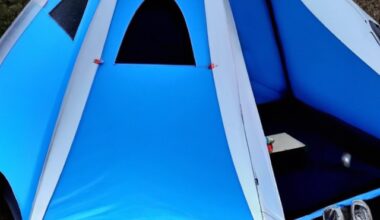During outdoor adventures in summer, you may want some shade to cool off the heat, but what if instead of deflecting heat, your tarp is actually trapping heat and improving discomfort. This is possible if you are using the wrong tarp color thus it might be doing more harm than good, trapping heat rather than bouncing it away.
Choosing the best color tarp to reflect heat can make all the difference when it comes to comfort, temperature control, and protecting your gear.This guide is all you need interms of chosing the best color tarp to reflect Heat which can enable you stay cool and protected no matter how intense the sun gets.
How Tarps Reflect Heat: The Science Behind it
To get why color matters, let’s start with the science. All colors have reflectivity, the refecltivity of a color is highly determined by the amount of light it reflects.
When sunlight hits a tarp, some colors absorb the light (and heat) while others reflect it. Dark colors, like black or navy, absorb most of the sunlight and get hot quickly. In contrast, lighter colors like white or silver reflect a higher percentage of sunlight, meaning they stay cooler.
It’s also worth noting that the material of the tarp plays a role. Certain materials, like polyethylene or reflective vinyl, are designed to enhance heat reflection, making them a smart choice for anyone prioritizing a cooler setup.
Which Colors Reflect Heat Best?

Different colors have varying levels of effectiveness in reflecting heat. Here’s how some of the top choices compare:
- White Tarps: White is often considered the best choice for reflecting heat. It bounces back a large portion of sunlight and helps keep the shaded area cool. Perfect for tents, canopies, or areas where you need a respite from direct sun.
- Silver or Reflective Tarps: Silver tarps are designed to reflect even more sunlight than white tarps. The reflective surface acts like a mirror, pushing heat away. These are ideal for situations where high heat reflection is a priority, such as covering equipment or vehicles.
- Other Light Colors (Yellow, Light Blue): While not as effective as white or silver, light colors like yellow or blue are still better than darker options. They reflect some light but may absorb more heat over time, so they’re a good option for mild climates.
Pros and Cons of Each Tarp Color for Heat Reflection

1. White Tarps
Pros:
Heat Reflection: White tarps are among the best at reflecting heat, as they bounce back a high percentage of sunlight, keeping the area beneath them significantly cooler. This makes them ideal for use in high temperatures when you need maximum shade and comfort.
Availability and Affordability: White tarps are easy to find and typically come at affordable prices, making them accessible for both personal and commercial use.
Versatility: These tarps are popular in many outdoor applications, from camping to construction, due to their reliable performance in sunny conditions.
Cons:
Easily Shows Dirt: The light color of white tarps means they can show dirt, stains, and wear more quickly than darker tarps. For people using them in dusty or muddy environments, this could mean frequent cleaning or replacements.
Potential Wear Over Time: Frequent cleaning may reduce the tarp’s durability, so white tarps might need to be replaced more often if aesthetic appearance is a priority.
2. Silver Tarps
Pros:
Highest Heat Reflection: Silver tarps are designed with reflective surfaces that maximize heat deflection, often outperforming white tarps in extreme heat. They are highly effective for intense sun exposure and are especially useful for protecting sensitive items, equipment, or vehicles.
Durability: Silver tarps are often manufactured to withstand UV exposure and harsh weather conditions, making them longer-lasting in outdoor settings.
Cons:
Higher Cost: Silver tarps are typically more expensive than standard white or colored tarps, partly due to their enhanced reflective and durable properties. This can be a drawback for those on a tight budget.
Slightly Harder to Find: Although they’re widely available, silver tarps may not be as common as other colors in local stores, so you may need to seek them out online or at specialized retailers.
3. Blue and Green Tarps
Pros:
Availability: Blue and green tarps are some of the most widely available colors and can be found at almost any hardware or outdoor supply store.
Durability for General Use: These tarps are built for general-purpose outdoor applications, like covering woodpiles, construction materials, or gear. They can withstand moderate weather and wear well in less intense sunlight conditions.
Cons:
Lower Heat Reflection: Blue and green tarps absorb more sunlight than white or silver, meaning they retain more heat. This makes them less effective at keeping shaded areas cool, which may be uncomfortable for those sitting underneath or trying to keep equipment cool.
Not Ideal for High Temperatures: In very hot conditions, blue and green tarps won’t offer the same relief as white or silver tarps, so they may not be the best choice for extreme sun exposure.
4. Darker Colors (Black, Brown)
Pros:
Durability and Strength: Dark-colored tarps, especially black and brown, are often made from thicker, more durable materials, making them resilient in rugged outdoor environments. They’re ideal for heavy-duty uses, such as construction or agricultural applications where strength and durability are essential.
Concealment and Privacy: Dark tarps offer a good level of privacy and can help hide valuable equipment or materials. Their colors are also useful for blending into natural environments, making them suitable for situations where a low profile is preferred.
Cons:
High Heat Absorption: Darker tarps absorb a significant amount of sunlight, causing the area beneath them to get noticeably hotter. This can make them uncomfortable for shaded areas where cooling is a priority.
Limited Heat Reflection: Since they trap rather than reflect heat, dark tarps are best used in cooler conditions or for applications where heat reflection isn’t a primary concern.
Factors to Consider When Choosing a Heat-Reflective Tarp

Beyond color, several factors impact how effective a tarp is at reflecting heat. Keep these considerations in mind when making your choice:
Purpose and Environment: Are you using the tarp for camping, covering equipment, or creating shade? Your intended use will help determine the best color.
Durability and Material: Polyethylene tarps are common, durable, and affordable. Reflective tarps, often coated in materials like aluminum, provide better heat resistance but are pricier.
Climate and Weather: If you’re in an area with extreme UV exposure, it’s worth investing in a higher-quality tarp with reflective capabilities.
Budget: White and silver tarps may cost a bit more but could pay off in terms of comfort and protection from the sun.
Additional Tips for Maximizing Heat Reflection with Tarps
Even with the right color tarp, there are ways to enhance its heat-reflective power:
- Double-Layering Techniques: If you need extra cooling, consider double-layering with a reflective tarp on top and a lighter one beneath to create an extra layer of heat insulation.
- Positioning and Angling: Set up your tarp to maximize shade. Angling the tarp slightly allows for better airflow and helps reduce trapped heat.
- Using Reflective Coatings: Some tarps come with UV-resistant coatings or additional reflective layers. These coatings can further block heat and prevent material degradation over time.
Top Recommended Heat-Reflective Tarps
Looking for a specific product recommendation? Here are a few popular options to consider for reliable heat reflection:
- White Poly Tarps: These are widely available, economical, and effective at reflecting heat for general purposes.
- Reflective Silver Tarps: Many brands offer reflective tarps designed for high UV exposure, ideal for protecting vehicles, boats, or outdoor setups.
- Canvas Tarps with UV Coating: If durability and strength are top priorities, consider a UV-coated canvas tarp, which balances heat resistance and long-term use.
When in doubt, check outdoor retailers and online stores for reviews to find the best fit for your needs.
Conclusion
Choosing the best color tarp to reflect heat can help you stay cool and protected when it matters most. White and silver tarps are top choices, each with unique benefits depending on your needs and budget.
A little investment in the right tarp color can go a long way in ensuring comfort and protection for you, your gear, and your surroundings. So the next time you’re out in the sun, don’t just pick any tarp—choose one that keeps the heat at bay.
Frequently Asked Questions
Q: Is a white or silver tarp better for reflecting heat?
A: Both are excellent options. Silver tarps often have the edge in intense heat due to their reflective coating, but white tarps are also very effective.
Q: Can I use a regular tarp and still get some heat reflection?
A: Light-colored regular tarps will reflect some heat, but they may not be as efficient as silver or UV-coated options.
Q: Does tarp thickness affect heat reflection?
A: Thickness does impact heat insulation, but color is the primary factor in how much heat is reflected.
Q: How long do heat-reflective tarps last in extreme conditions?
A: This depends on material quality and exposure, but high-quality UV-resistant tarps can last several years with proper care.



